Now that
a bipartisan group of U.S. senators and
the president have made specific proposals to reform immigration law, you’ll see months of controversy. As is frequent in politics, the most controversial policy step will be among the least important.
I’m talking about the provisions, in both proposals, for an “earned path to citizenship” for the
11 million people residing in the U.S. without legal permission. (People who like this plan call it “
regularization”, people who dislike it call it “
amnesty”.) Showcase policy steps like this don’t affect unauthorized immigration nearly as much as the pathways for U.S. employers to smoothly, flexibly hire foreign labor when they need to.
Read this twice: I am not saying that the status of unauthorized immigrants isn’t important. I’m saying that the policy step of a path-to-citizenship is unlikely to be an important determinant of the unauthorized immigrant population, even in the short term.
This is clear from U.S. history. In 1986,
President Ronald Reagan created a path to citizenship for most of the 3 million unauthorized immigrants then living in America when he signed the
Simpson-Mazzoli Act. Watch what happened to the unauthorized immigrant population. By 1990, just four years later, you couldn’t even tell that anything had happened:
 Source: R.E. Wassem (2012), Unauthorized Aliens Residing in the United States: Estimates Since 1986. Washington, DC: Congressional Research Service, p. 3.
Source: R.E. Wassem (2012), Unauthorized Aliens Residing in the United States: Estimates Since 1986. Washington, DC: Congressional Research Service, p. 3.
The economic research on this subject is clear. Economists
Pia Orrenius and
Madeline Zavodny have written in
their excellent review:
“These experiences show the importance of enacting a legalization program only in the context of comprehensive immigration reform designed to reduce future unauthorized inflows as much as possible. Flows increased following IRCA because the amnesty did little to reduce the demand for unauthorized workers […]”
The extreme controversy over the 1986 path to citizenship was like worrying about how to pay today’s $100 debt while ignoring the mounting expenses that will give you a $1,000 debt next year. Leaders truly concerned about America and the people who live here have a responsibility to offer long-term solutions.
We don’t know yet exactly what the Senators and the president propose as a long-term solution. The Senators’ proposal
claims that it “will provide businesses with the ability to hire lower-skilled workers in a timely manner when Americans are unavailable or unwilling to fill those jobs.” How they do this, and whether or not it truly serves U.S. employers’ needs, will do by far the most to determine whether or not tomorrow’s America is a land of unauthorized immigrants. Orrenius and Zavodny
propose a flexible system of auctioned work permits that would be a boon to U.S. enterprise and a big stimulus for the U.S. economy, particularly agriculture (details in
their book). CGD’s Lant Pritchett discusses some of the global economic benefits of guest-work arrangements
here.
But the exact way of handling future flows is less important than an overall focus on working
with American employers. Any immigration reform proposal serious about reducing unauthorized immigration must focus on creating tools for U.S. business, not chains for U.S. business. Past attempts at addressing future flows have been chains instead of tools. Today’s H-2A visa for seasonal agricultural work is a good example. It is so cumbersome and expensive to use that the vast majority of American farmers—who depend critically on migrant labor—
refuse to use it. The program doesn’t
help farmers get the labor they need, doesn’t help connect them to workers by facilitating recruitment; it exclusively
puts up costly barriers for farmers to fight through in order to access legal migrant labor.
If you’re concerned about the phenomenon of unauthorized immigration or the plight of unauthorized immigrants, pay less attention to the path-to-citizenship. Keep one question foremost in your mind as you read the forthcoming details of the Senators’ and president’s proposals: What are they offering U.S. farmers to get the labor they need without going under? What are they offering U.S. parents to get the childcare they need without breaking the bank? These are the provisions that will shape unauthorized immigration for tomorrow’s America.
CGD blog posts reflect the views of the authors, drawing on prior research and experience in their areas of expertise.
CGD is a nonpartisan, independent organization and does not take institutional positions.






